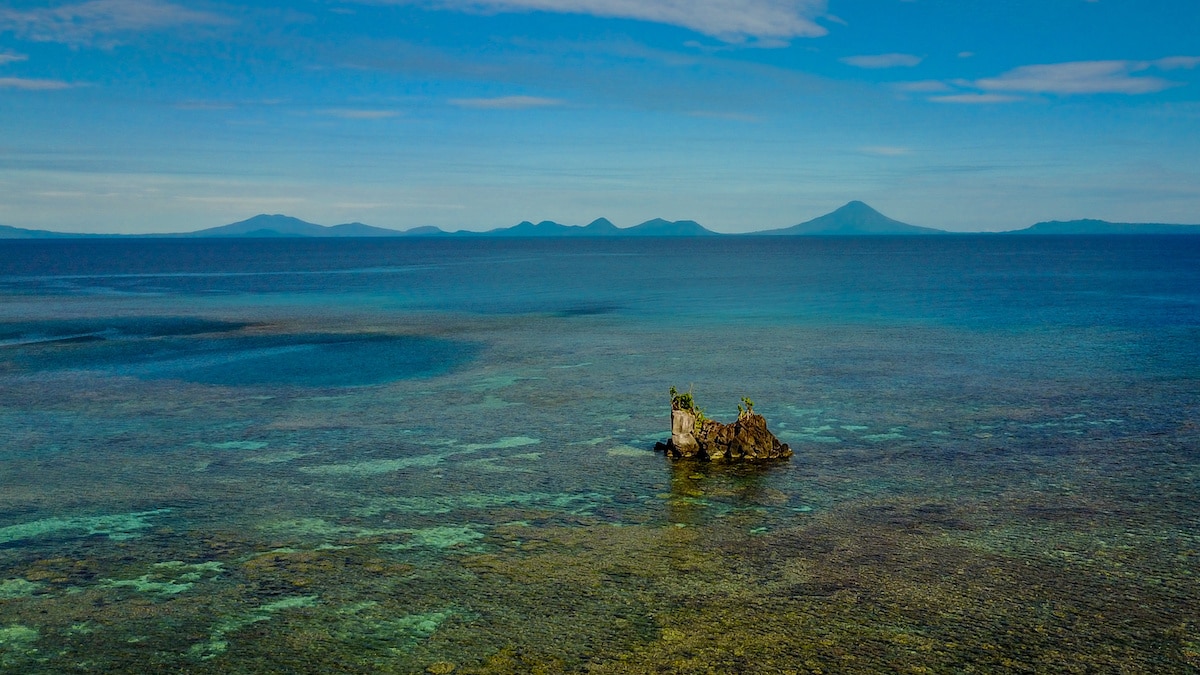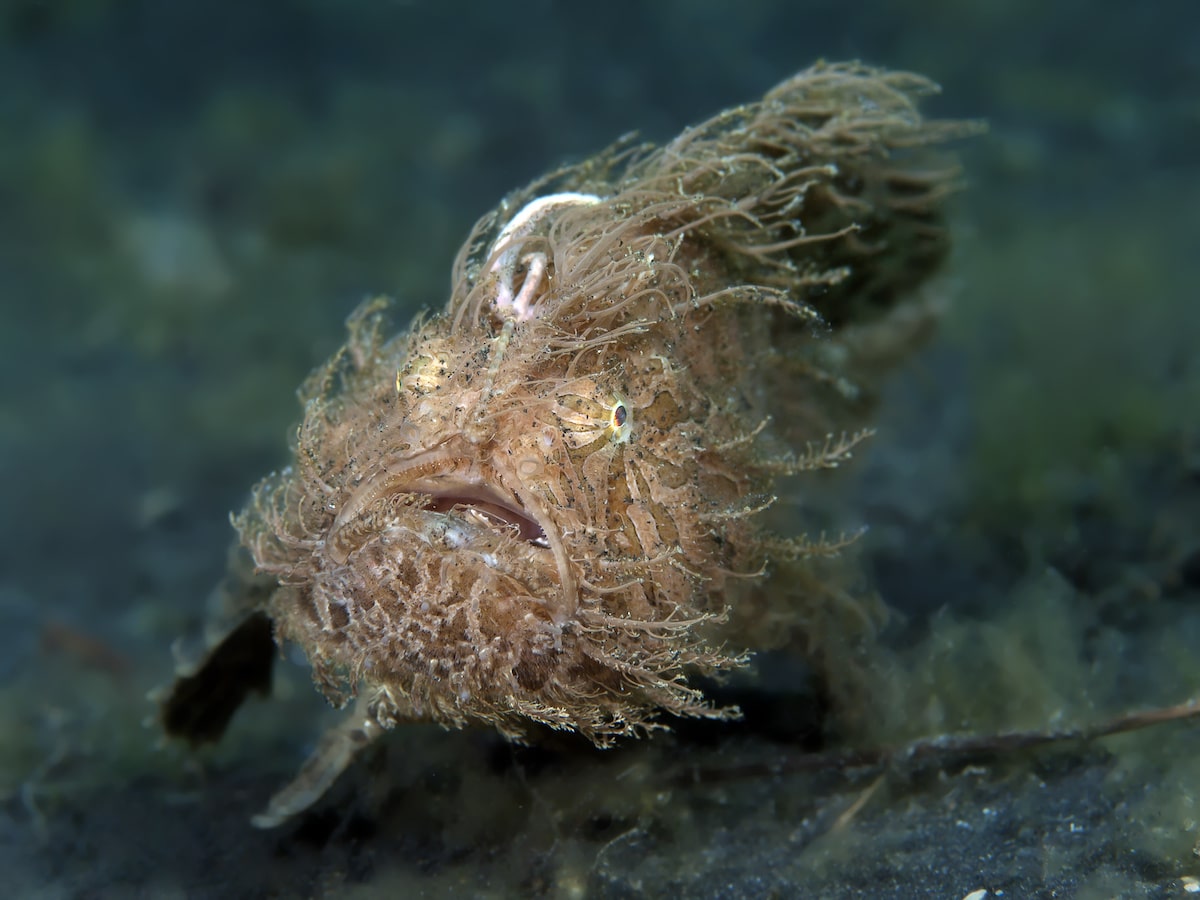News
The weird and wonderful world of Muck Diving

Muck diving takes you into an exciting new world, with weird and wonderful critters and a staggering array of life. It’s a great way to test your observation and buoyancy skills; hovering above black sands in search of impossibly small life.
If you want to see what whacky creatures’ nature can truly come up with, muck diving is for you.
Where can you go muck diving?
There are some great muck diving destinations to choose from, usually found at volcanic areas and seagrass beds. Here’s our pick of some of the best hotspots to try:
Indonesia
The ‘muck diving capital of the world’, Lembeh Strait has over 60 dive sites to explore and is perfect for muck diving photography, thanks to the black sands found there.
Alor is another Indonesia diving highlight, with black volcanic sands, vibrant reefs, and underwater lava flows.
In contrast, Ambon has white sands and coral bommies teeming with muck critters. Whichever area you choose, you’ll be surrounded by diverse marine life.
If you’re more into coral reefs but want to give muck diving a go, Wakatobi is a good choice. A group of 4 remote islands and UNESCO Marine Biosphere Reserve, this stunning area has plenty of macro life amongst the corals and seagrass beds.
The Ondina liveaboard is a good choice for muck divers. This traditional phinisi cruises Lembeh, Alor and Ambon (plus other Indonesia dive areas), visiting a variety of muck and non-muck diving sites.
Philippines
Philippines diving offers plenty of muck diving and is an increasingly popular choice, thanks to its diverse macro life and thousands of islands dotted in turquoise waters.
Dauin is known for its exceptional water visibility, perfect for finding critters, and coral reef diving. Cabilao Island at Bohol has vibrant reefs and numerous critters, plus big pelagics and drift dives.
Whilst Moalboal may be known for its sardine run, it’s also great for muck diving and night diving at Pescador Island. If you want to find spooky-looking Bobbitt worms, be sure to dive at Puerto Galera.
Other Philippines muck diving highlights include Southern Leyte and Romblon. Romblon is becoming famous thanks to the abundance of ghost nudibranchs found there, as well as other rare nudibranchs and four types of pygmy seahorses.
The Philippine Siren liveaboard is a popular choice, offering luxurious cruises to Dauin, Cabilao, Pescador and more.
Papua New Guinea
Milne Bay, the iconic home of muck diving, has it all; black sands, coral beds and old tree branches that host diverse and plentiful macro life. There are numerous muck diving sites to explore, including Dinah’s Beach – where muck diving began in the 1980s.
The surrounding coastline and islands don’t just offer black sands. There are also coral dives, wall dives, World War II wrecks and vibrant coral gardens.
If you’re going Papua New Guinea scuba diving be sure to also visit Kimbe Bay. Surrounded by sleepy volcanoes, the colourful coral reefs at Kimbe host hundreds of fish species and there are black sands at Wire Bay.
The MV Chertan liveaboard offers reef and muck trips, plus dedicated muck trips to Milne Bay. The experienced crew are great for spotting critters you might just miss without them.
What can you see muck diving?
Muck diving is truly a feast for the eyes, with an almost endless list of tiny creatures to find.
Fans of octopi can search for blue-ringed, mimic, wonderpus and coconut octopus. Meanwhile, frogfish fans won’t be disappointed with white, black, yellow, giant, orange-painted, psychedelic and hairy frogfish to find.
Pygmy seahorses, sea moths and ghost pipefish are highly sought after in the Philippines, where you can also find waspfish plus grumpy-looking stargazers in the sands.
Mandarinfish are perhaps the most well-known muck diving critter to find. These colourful and easily-recognisable fish are well worth searching for.
If you don’t want to spend all your time searching for tiny critters, you can also find larger life at top muck diving destinations:
- Alor is great for whale and dolphin encounters
- Wakatobi hosts mantas and whale sharks
- Moalboal’s sardine run offers fast-paced pelagic action
Can anyone try muck diving?
Absolutely. There are a variety of shallow and deep muck dives, making it suitable for all. Just remember you need good buoyancy and fin kicking skills to ensure you don’t disturb the fine sands.
What dive gear do you need to try muck diving?
A camera is a must-have item for muck divers. You might also want to carry a muck stick, to stabilise yourself whilst hovering above the sands. A torch is also helpful for spotting small life and highlighting their different colours.
This article was written by divers and writers at LiveAboard.com
Gear News
Introducing the TR-80, IR-50 and CS-30 Regulators from DYNAMICNORD

Whether you are a beginner or a professional diver – with the three new main regulators from DYNAMICNORD, everyone will find their favourite regulator. They all look super stylish.
Excellent performance with the TR-80
Quality and performance are the be-all and end-all for regulators. It is not for nothing that the TR stands for Tec Reg. The innovative design of the TR-80 guarantees absolute reliability – even in ice-cold waters.

Perfect breathing effort at 0.8 J/l / certified for diving in waters below 10 degrees / structural design made of solid brass for best cold protection / membrane-compensated design with dry seal of the first stage / reduced exhalation effort thanks to optimized exhalation membrane and bubble deflector / adjustable Venturi (dive/predive) and adjustment knob for individual inhalation comfort / innovative design of the front cover prevents free-flow in strong currents or when diving with scooters / design made of sandblasted brass, matt chrome finish / 2 HP and 4 LP outlets / mouthpiece made of high-quality, anti-allergic silicone for maximum comfort.


Amazing underwater adventures with the IR-50
The IR-50 is the top regulator for advanced and experienced divers. Natural breathing is the essence of this regulator.

Ideal breathing effort at 0.8 J/l /certified for diving in waters below 10 degrees / compensated membrane / adjustable venturi (dive/predive) and adjustment knob for individual inhalation comfort/ outlet valve and deflector for minimum exhalation effort and reduction of bubbles on the face / design made of sandblasted brass, matt chrome finish / 2 HP and 4 NP outlets / mouthpiece made of high-quality, anti-allergic silicone for maximum comfort.


The Workhorse – our CS-30
For diving centres and diving beginners – the workhorse stands for strong construction, reliability and robustness. Perfect for your training.

Optimal breathing effort at 0.8 J/l /recommended for diving in waters above 10 degrees / non-compensated piston / adjustable venturi (dive/predive) / outlet valve and deflector for minimum exhalation effort and reduction of bubbles on the face / design made of sandblasted brass, matt chrome finish / 1 HP and 3 NP outlets / mouthpiece made of high-quality, anti-allergic silicone for maximum comfort.


Octopus OP-30
The OP-30 is the ideal addition to all DYNAMICNORD regulators. It is identical in construction to the CS-30.

The TR-80, IR-50, CS-30 (DIN & INT) regulators and the Octopus OP-30 are available from DYNAMICNORD dealers and in the online store.
DYNAMICNORD – Your Outdoor Companion.
Marine Life & Conservation
Paul Watson Released as Denmark Blocks Japan’s Extradition Bid

Renowned anti-whaling activist Paul Watson has been released from custody in Greenland after spending five months in detention. Denmark’s Justice Ministry rejected Japan’s request for his extradition, citing insufficient guarantees that his time already served in custody would be credited against any potential sentence.
The 74-year-old Canadian-American was arrested on July 21 in Nuuk, Greenland’s capital, when his ship docked to refuel. His arrest was based on a 2012 Japanese warrant related to a 2010 encounter in Antarctic waters. Japan alleged Watson obstructed operations and caused damage to a whaling research ship during efforts to disrupt illegal whaling. Watson has consistently denied these claims, maintaining his commitment to marine conservation.
Denmark, which oversees extradition matters for Greenland, concluded that while the legal conditions for extradition were met, the lack of assurances from Japan regarding time-served credit made extradition untenable.
In a video shared by his foundation, Watson expressed gratitude and relief, saying, “After five months, it’s good to be out… and good to know they’re not sending me to Japan.” He added that the most difficult part of his time in custody was being separated from his two young sons.
Watson is a pioneering figure in marine conservation, known for founding the Captain Paul Watson Foundation in 2022 after decades of activism with the Sea Shepherd Conservation Society. His bold efforts to defend marine life have earned him widespread support, including from celebrities and conservationists. His work has also been featured in the acclaimed reality TV series Whale Wars.
Watson’s lawyer, Jonas Christoffersen, praised the decision, stating, “We are happy and relieved that Paul Watson is now free.” He added that Watson is eager to reunite with his family and continue his vital work.
The arrest occurred while Watson’s vessel, the M/Y John Paul DeJoria, was en route to the North Pacific with a team of 26 volunteers to intercept a Japanese whaling ship. His foundation described the arrest as politically motivated and emphasized that Watson’s actions were focused on ending illegal whaling practices.
Japan resumed commercial whaling in 2019 after leaving the International Whaling Commission, asserting that whale meat is a cultural tradition. Conservationists, however, continue to challenge these practices, highlighting their impact on marine ecosystems.
Despite the challenges, Watson remains steadfast in his mission to protect marine life and bring attention to whaling practices. His dedication to ocean conservation has made him a globally respected advocate for the environment.
-

 News2 months ago
News2 months agoIconic SS United States to become the World’s Largest Artificial Reef
-

 News3 months ago
News3 months agoBook Review – 52 Assignments: Underwater Photography
-

 Gear News3 months ago
Gear News3 months agoDYNAMICNORD – New German diving brand enters the British market
-

 News3 months ago
News3 months agoExploring Cenote El Pit: A Diver’s Dream
-

 Gear News3 months ago
Gear News3 months agoTry BARE drysuits (and maybe even win one!) this Friday with Sea & Sea at North West Dive Fest
-

 Marine Life & Conservation3 months ago
Marine Life & Conservation3 months agoBook Review: Coral Triangle Cameos
-

 Blogs2 months ago
Blogs2 months agoDive the Egyptian Red Sea this Autumn with Regaldive
-

 News3 months ago
News3 months ago2024 Ocean Art Underwater Photo Competition Announced




















